ASUS Zenbook Prime (UX21A) Review: The First of the 2nd Gen Ultrabooks
by Anand Lal Shimpi on May 22, 2012 2:46 PM EST- Posted in
- Laptops
- CPUs
- Asus
- Ivy Bridge
- Zenbook
- Zenbook Prime
- Ultrabook
- Notebooks
The Test
To keep the charts clean and simple I omitted a lot of the config details of each of the notebooks. For your reference, here's the configuration of each of the notebooks in our tests:
Dell Inspiron 11z (SU4100 + GMA4500 + HDD + 56Wh)
Performance
As I mentioned earlier in this review/preview, the deal ASUS worked out with Intel prevents us for discussing clock speeds or specifications of the ULV Ivy Bridge silicon in the Zenbook Prime. Obviously the silicon is going to fit within the same 17W TDP as its predecessor so don't expect huge differences in clock speeds.
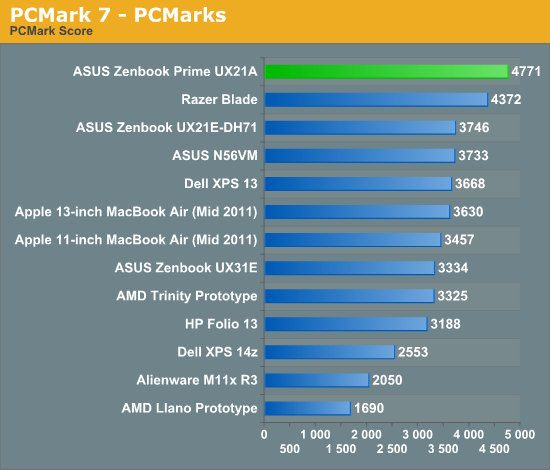
If you take into account Quick Sync and its SSD, the Zenbook Prime is an extremely quick solution. Looking at the breakdown of PCMark scores you get a much more realistic look at where the ULV IVB fits into things.

In some areas the Sandisk U100 holds the Zenbook prime back, here it's actually slower than its predecessor. Despite all of its issues throughout most of last year, SandForce was always fast.

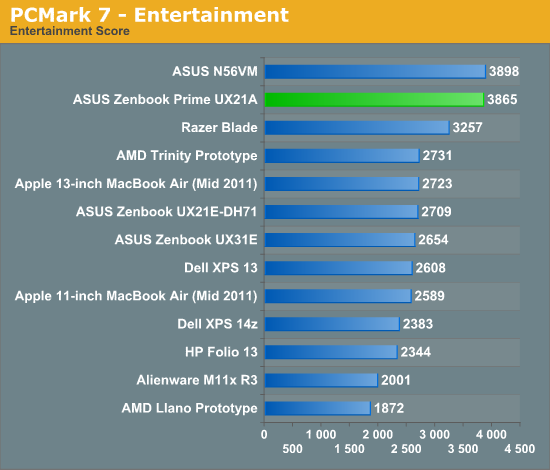

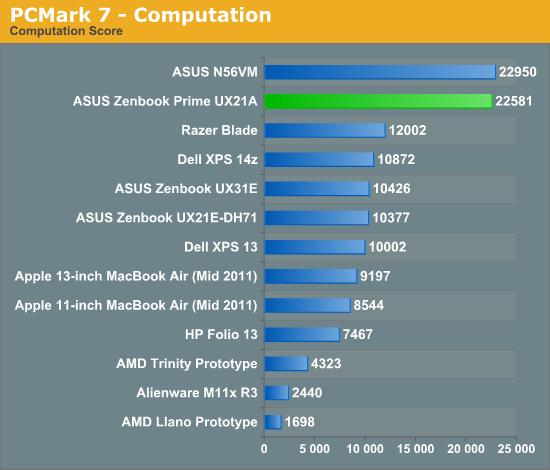
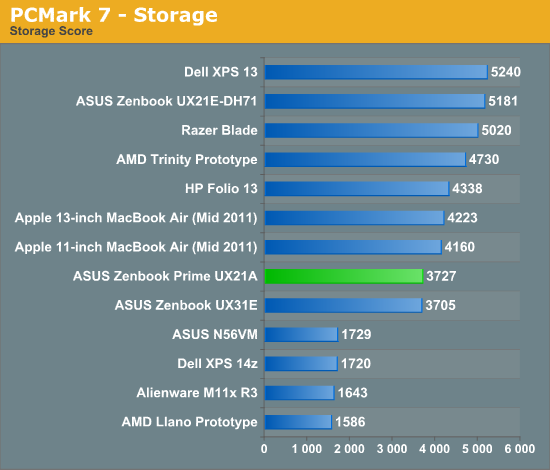
I threw in a PCMark Vantage graph as we have a lot of older data in that benchmark that can help put things in perspective:
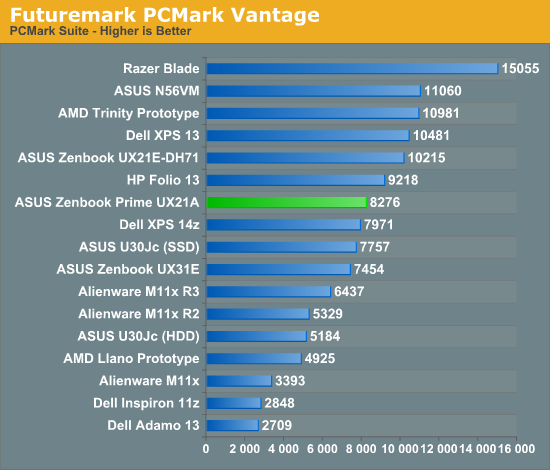
It's amazing the sort of performance gains we're able to show over the older Core 2 based ultra portables like the Dell Inspiron 11z and Adamo 13. Again we see a slight performance deficit versus the SandForce based UX21E.
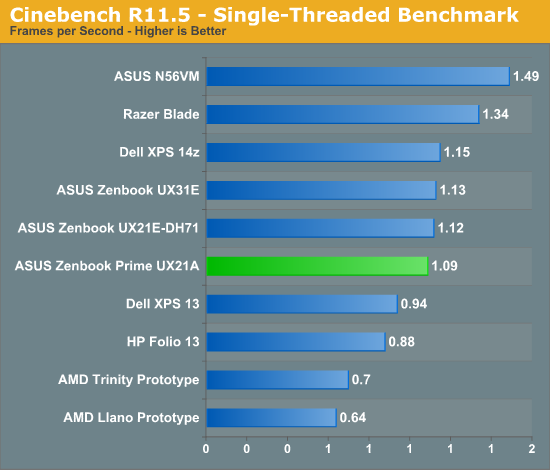
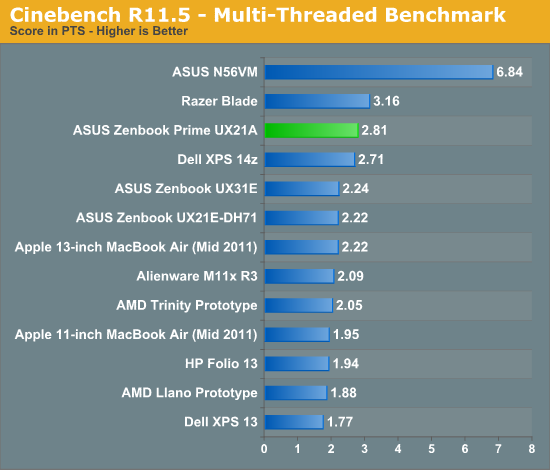

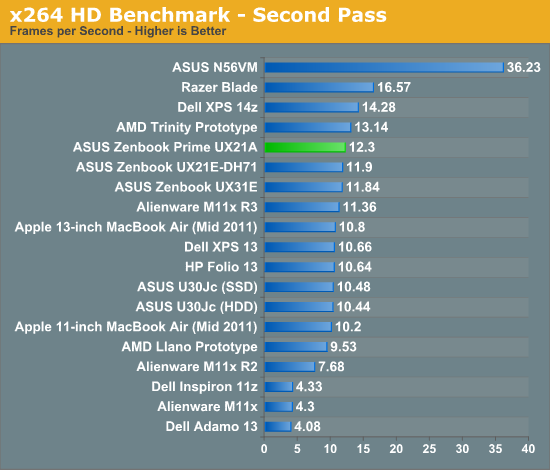










192 Comments
View All Comments
zappb - Sunday, May 27, 2012 - link
11 inch 1080p = Asus = Awesome...That just takes some balls!
Thanks Asus
stoked - Sunday, May 27, 2012 - link
Can someone comment on the difference between the UX31A-DB51 and UX31A-DB52 for the $100 difference in price?Rudyji - Wednesday, September 19, 2012 - link
51 : i5 128gig SSD52 : i5 256gig SSD
71 : i7 128gig SSD
72 : i7 256gig SSD
Rudyji - Wednesday, September 19, 2012 - link
or maybe its the RAM...it isnt all that clear....shriganesh - Monday, May 28, 2012 - link
The high res screen rocks. There is another albeit unconventional one. We can reduce the resolution. In fact I am not too comfortable with 1080P resolution in my 23" monitor. So I use it with 720p resolution which has least artifacts due to more physical dots showing less number of pixels. There sure are artifacts and jagged lines which make the text and things less sharp. But it puts extremely low stress on eyes.waqqashanafi - Monday, May 28, 2012 - link
I can't wait to get my hands on one of these Zenbook Primes. The only issue I have with such a mobile laptop is the lack of the obvious: 4G LTE!A laptop like this NEEDS to have 4G LTE built-in, in this day when mobile data is cheap and available everywhere, and people are more and more mobile. I want to be able to just flip this bad boy open anywhere (offices, cafes, in the car, park, friend's house, etc.) without having to beg for other people's WiFi passwords - or have ugly fat 4G LTE dongles sticking out of my laptop or do some shaky tethering with my phone.
Filiprino - Monday, May 28, 2012 - link
I've read on a lot of sites that the UX32VD has a mini displayport instead of a mini vga. The only ones that have a mini vga are the revisions of UX21E and UX31E, that is, the UX21A and UX31A.igneshto1 - Sunday, June 3, 2012 - link
http://www.youtube.com/watch?v=xD2MnzoirNIThis video(In russian, I know!) goto 3:08... i7-3517U @ 1,90Ghz up to 2,40Ghz... Just so you know...
jonyah - Tuesday, June 5, 2012 - link
These ultrabooks are so close to being great, but they miss the mark. Limiting your machine to 4gb of memory, or putting in a hybrid drive where you should have an ssd really sucks. make it 8gb of memory at least (more would be better), keep the full hd screen and stick with just pure SSD and you have a winner. It may even compete with my Vaio Z enough for me to pick one up instead of a new Z next time. I want a U31A with 8gb of memory. How hard is that? Or the UX32VD with 8gb of memory and 256gb SSD.smartypnt4 - Thursday, June 7, 2012 - link
Get a UX32VD, pick your favorite 256gb drive, grab a 4gb stick of memory (or an 8gb stick if it supports it) and upgrade the thing yourself.The UX32-series all has one stick of user-replaceable RAM, and a user-replaceable HDD that's a standard 2.5" drive. Make sure it's a slim 7mm drive, though. All of Intel's drives are 7mm drives with spacers to make them 9.5mm, so they all fit. Not sure about others.
If I get a new laptop any time soon, that's my plan anyway. It'll be around $1700, but if you're already looking at the Vaio Z, then that won't be too high a price point for you. With this, you get on-board discrete graphics too.